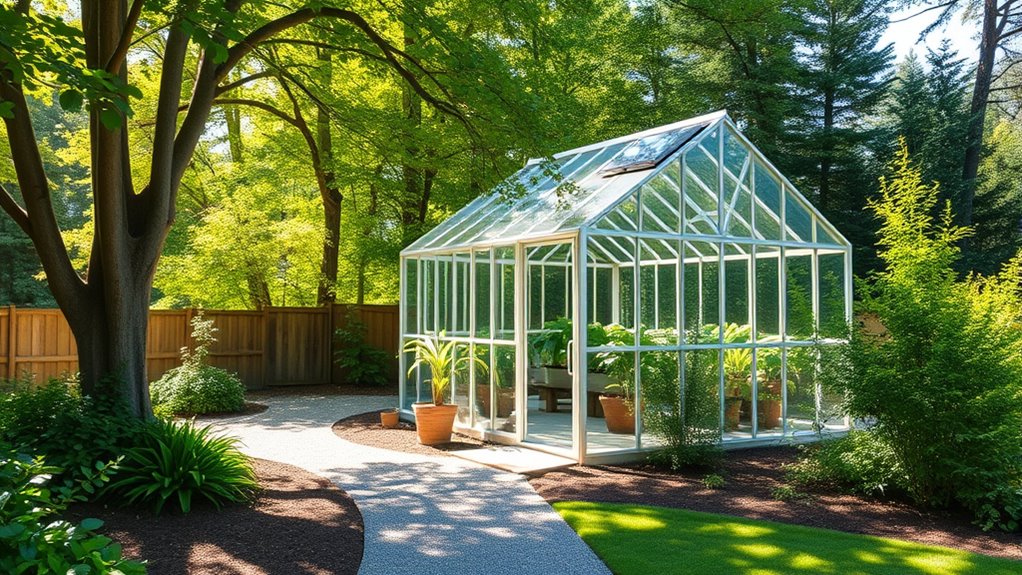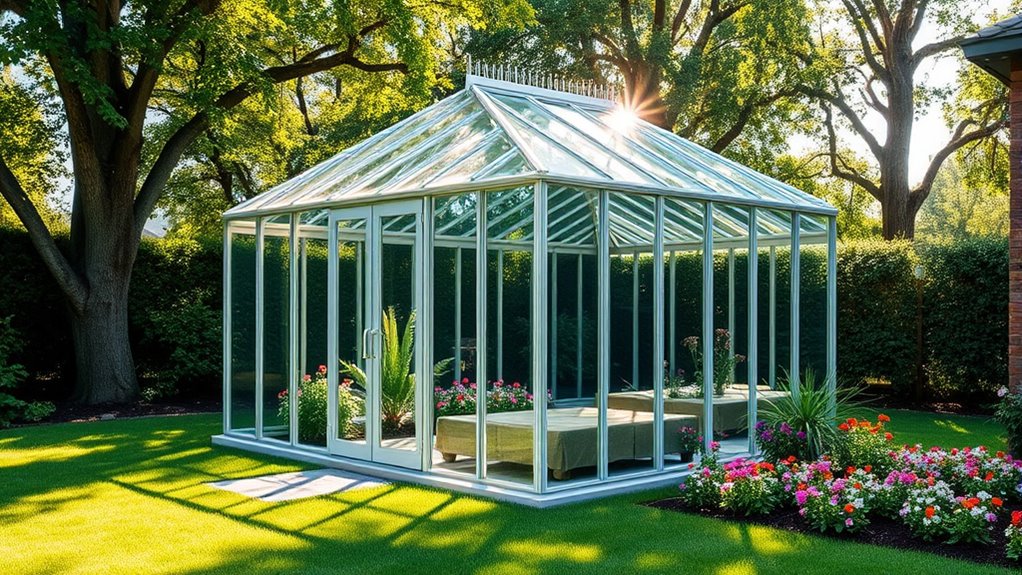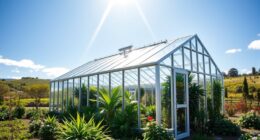To find the best spot for your greenhouse, choose a location with good airflow and minimal shading, ideally on a gentle slope to prevent water runoff. Place vents and windows where they can maximize natural cross-ventilation and consider protecting it from harsh winds and extreme temperatures. Materials and insulation also play a role in climate control. By selecting a strategic spot, you’ll improve plant health and energy efficiency—keep exploring for tips to optimize your setup.
Key Takeaways
- Choose a well-drained, level area with good natural airflow to promote healthy plant growth and efficient ventilation.
- Position the greenhouse where it receives ample sunlight, ideally facing south for maximum light exposure.
- Avoid placing near tall trees or structures that could cast shadows or obstruct airflow and ventilation.
- Ensure easy access for maintenance and proximity to water and utilities for convenience.
- Consider prevailing wind directions to enhance natural cross-ventilation and reduce reliance on mechanical systems.

Have you ever wondered where to place your greenhouse to get the best results? Choosing the right spot isn’t just about aesthetics; it directly impacts plant health, energy efficiency, and ease of maintenance. One of the most important factors to consider is ventilation strategies. Proper airflow prevents overheating, reduces humidity, and minimizes disease risks. Ideally, position your greenhouse where you can incorporate natural ventilation options, such as side vents, roof vents, or exhaust fans. Look for a location that allows for cross-ventilation—placing vents on opposite sides creates a steady airflow that keeps temperatures regulated and air fresh. If natural airflow is limited, you may need to supplement with mechanical ventilation, but the initial placement should maximize passive cooling and airflow as much as possible. Additionally, considering materials and insulation can significantly influence the greenhouse’s temperature stability and overall performance.
Frequently Asked Questions
How Much Sunlight Does My Specific Plant Need Inside the Greenhouse?
Your plant needs about 6 to 8 hours of direct sunlight daily inside the greenhouse. To achieve this, consider plant shading and adjust for sunlight duration based on the plant’s specific requirements. Monitor how much light it gets each day, and if it’s too much or too little, modify with shading or relocate the plant. Proper sunlight guarantees healthy growth and maximizes your greenhouse’s potential.
Can I Place a Greenhouse on Uneven or Sloped Terrain?
You can place a greenhouse on uneven or sloped terrain, but you need to take terrain considerations and slope stabilization into account. First, level the ground to prevent shifting or tilting. Second, stabilize the slope to avoid erosion or sliding. Third, ensure proper drainage to prevent water pooling. By addressing these factors, you create a stable, safe environment for your greenhouse, maximizing your gardening success regardless of terrain challenges.
What Are the Best Nearby Structures to Protect Against Wind Damage?
You should look for windbreak barriers or natural shelter nearby to safeguard your greenhouse from wind damage. Strategically placing your greenhouse near sturdy fences, dense trees, or shrubs creates a natural shelter that reduces wind impact. These structures act as effective windbreak barriers, shielding your plants and greenhouse. Positioning your greenhouse close to these natural or man-made barriers ensures better protection and minimizes potential damage from strong winds.
How Close Should My Greenhouse Be to My House or Water Source?
You should place your greenhouse within 10-20 feet of your house for easy water access and proximity to tools, making daily tasks more convenient. This close placement guarantees you can efficiently water plants and quickly grab supplies without trekking across your yard. Keep it near your water source and storage areas, reducing effort and time, so you can focus on gardening instead of logistics.
What Are the Legal Restrictions for Building a Greenhouse in My Area?
You need to check local zoning regulations to see if building a greenhouse is allowed in your area. Many places require a building permit, especially for larger structures. Contact your city or county planning office to find specific restrictions, setbacks, or height limits. Failing to follow these rules could result in fines or having to dismantle your greenhouse. Always get the necessary approvals before starting construction.
Conclusion
By choosing the perfect spot, you create a cozy, consistent climate for your crops to flourish. Focus on sunlight, shelter, and soil, and you’ll foster a flourishing, foolproof fortress for your greenery. Remember, strategic placement sparks success, so stay mindful of your yard’s unique features. With a little planning and passion, your greenhouse will grow into a gorgeous, green haven, humming with health and harmony—making your gardening goals truly come to life.









